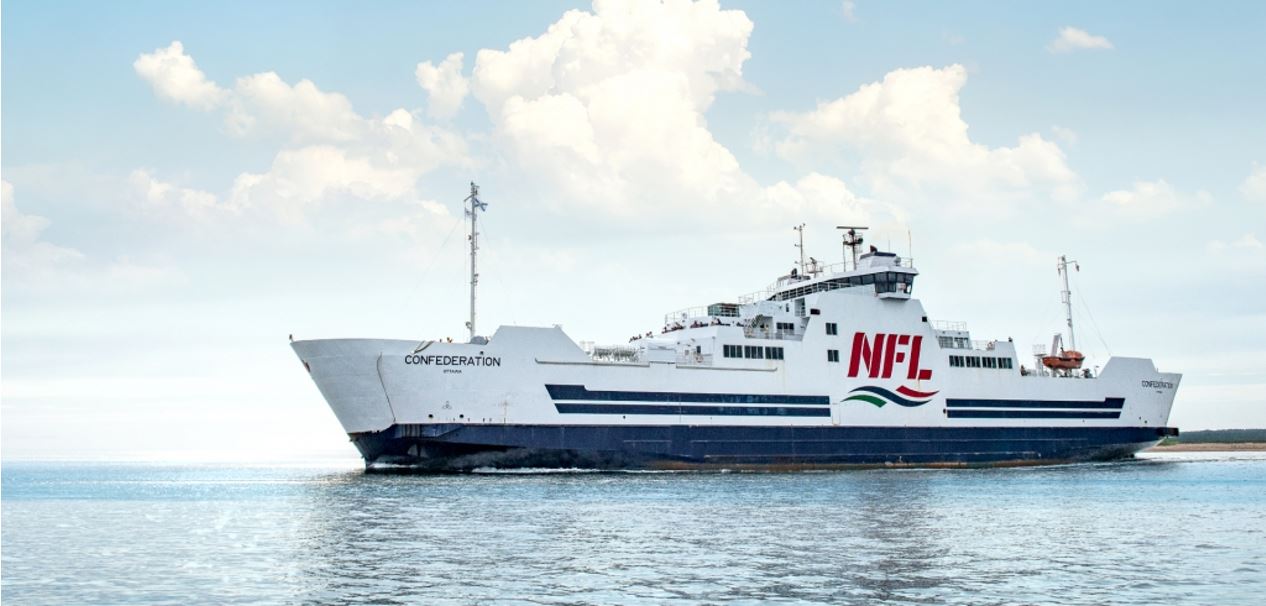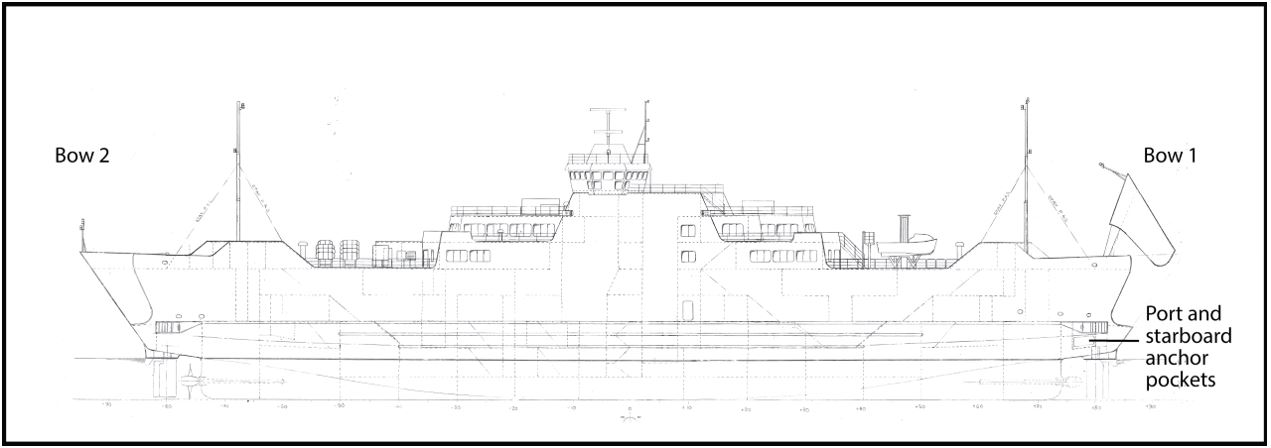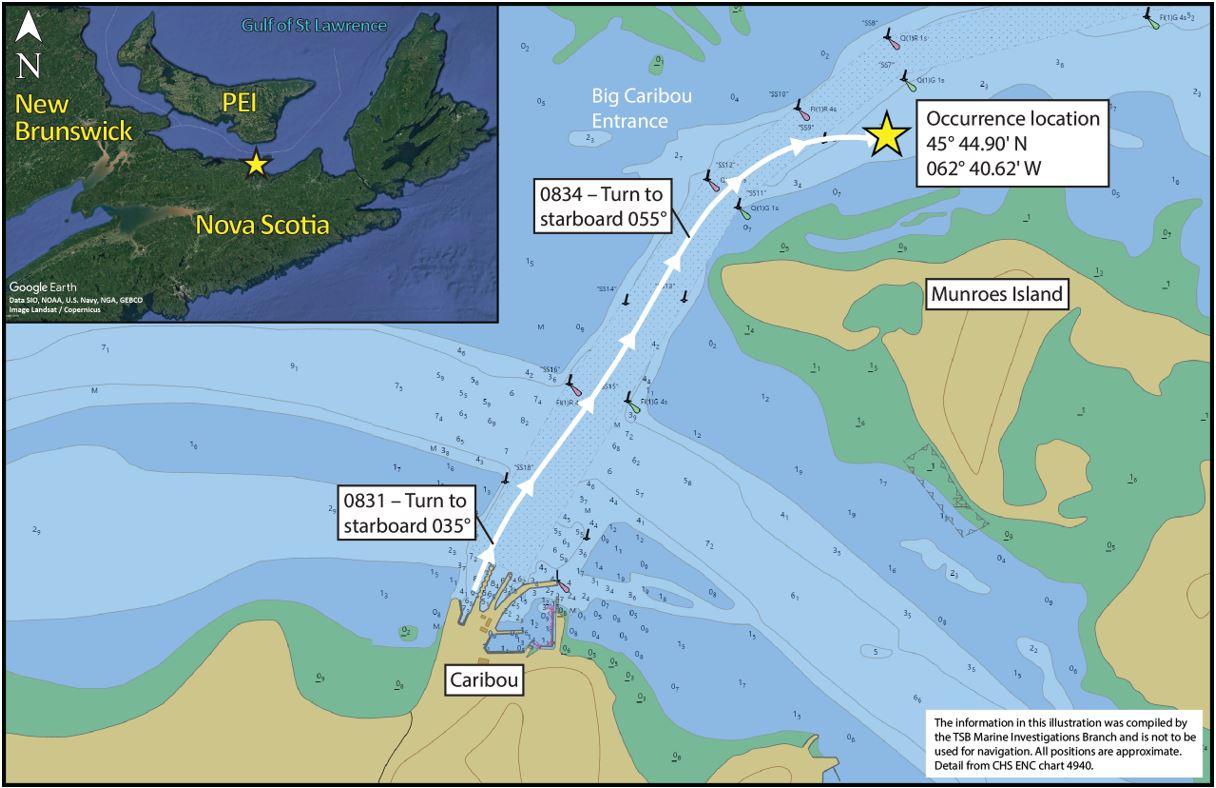Loss of steerage and grounding
Roll-on/roll-off ferry Confederation
Caribou, Nova Scotia
The Transportation Safety Board of Canada (TSB) investigated this occurrence for the purpose of advancing transportation safety. It is not the function of the Board to assign fault or determine civil or criminal liability. This report is not created for use in the context of legal, disciplinary or other proceedings. See Ownership and use of content. Masculine pronouns and position titles may be used to signify all genders to comply with the Canadian Transportation Accident Investigation and Safety Board Act (S.C. 1989, c. 3).
Description of the vessel
The Confederation is a double-ended roll-on/roll-off ferry of steel construction (Figure 1) built in 1993, with a passenger capacity of 599 and a vehicle capacity of 210. The bridge is enclosed and is equipped with navigational equipment including radars, very high frequency (VHF) radios, an electronic chart system, and a simplified voyage data recorder. The vessel is powered by 2 keel-cooled diesel engines with a total of 6000 brake horsepower. Each engine is connected by a gearbox to a controllable pitch propeller, and a Becker rudder is fitted on each end of the vessel. The vessel has a gross tonnage of 8060.8 and a cruising speed of 18 knots.
The vessel is registered to the Minister of Transport of the Government of Canada, which is also the authorized representative (AR), and operated by Northumberland Ferries Limited (NFL). The classification society Lloyd’s Register is the recognized organization (RO) for the Confederation.
The Confederation can be steered from the following locations:
- the main steering and propulsion control console in the centre of the bridge;
- from 1 of the 2 identical steering positions located at the centre of the bridge, one facing Bow 1 and the other facing Bow 2 (Figure 2); whichever one is forward-facing is used when the vessel is underway; and
- from the bridge wing consoles, which are used primarily for docking and undocking the vessel.
When the vessel is underway,Footnote 1 the main propulsion is from the stern, the main rudder is the aft rudder, the forward propeller is declutched, and the forward rudder is locked in the midship position. When the vessel is docking and undocking, the rudders and propellers on both ends are used.
The vessel operates on a 75-minute route that crosses the Northumberland Strait between Caribou, Nova Scotia, and Wood Islands, Prince Edward Island, running 3 to 8 times per day, depending on the season.
History of the voyage
On 04 September 2022 at 0807,Footnote 2 the Confederation arrived at Caribou from Wood Islands. Passengers and vehicles were disembarked, and the vessel began loading passengers and a number of vehicles for the return trip. The bridge team consisted of the master, the second officer, and the quartermaster.
At 0829, with the tide ebbing and a light breeze, the vessel departed the Caribou ferry terminal and then made the first turn to starboard to proceed out of the channel on a course of 035 degrees, increasing to a speed of 11 knots.Footnote 3 The quartermaster was steering the ship from the main steering position facing Bow 2. The master was controlling the propellers and engines from the starboard (east) bridge wing console.
At 0834, the master declutched the forward propeller (Bow 2), transferred control of the propellers and engines to the centre bridge console, where the second officer took control, and then moved from the bridge wing to the centre bridge console.
At the same time, the quartermaster began a turn to starboard (Figure 3). Once the vessel reached the desired heading, he applied the rudder to port to straighten the vessel course on a heading of 055 degrees.
At 0835, the quartermaster told the master that the vessel was continuing to turn rapidly to starboard and was not responding to the hard-to-port rudder command.
From the centre bridge console, the master confirmed that the rudder angle indicator was hard to port. At 0835:14, the master put the propellers astern and ordered the standby crew to drop both anchors. The vessel continued to starboard and started moving out of the channel at 0835:44.
At 0837, the vessel came to a stop with both anchors deployed (Bow 1 then became the forward bow). The master conducted a successful steering test from the wheelhouse, and the master and the engineers confirmed that the rudder was operable. A few minutes later, the public address system was used to inform passengers that the vessel was experiencing mechanical issues.
Between 0843 and 0852, the master made multiple attempts to raise the anchors, but they could not be raised because of the load on the anchor chains.
At about 0914, the master used the Bow 2 propeller to reduce the load on the anchor chains and attempted to raise the anchors again. From 0930 to 0932, the master added the Bow 1 propeller in an attempt to further reduce the load on the anchor chains.
At 0939, the aft engine shut down due to a high cooling water temperature and shortly afterward the forward engine shut down for the same reason. Without the engines, the crew stopped their attempts to raise the anchors.
At 0942, the crew determined that the vessel was aground on a mud bank due to the falling tide.
At 0944, the master requested that the vessel’s tanks be sounded.Footnote 4
At 0945, the master and the shore staff began to discuss preparations to get passengers off the vessel. The master requested a passenger count from the bridge team, and at 0956 the master received an official passenger count of 217.
At 0955, as the tide continued to fall, the vessel began listing to port.
At 1002, the Joint Rescue Coordination Centre (JRCC) in Halifax, Nova Scotia, received a call about the incident from a concerned third party. JRCC personnel asked Sydney Marine Communications and Traffic Services (MCTS) to contact the Confederation.
At 1003, NFL shore staff informed the JRCC that the Confederation was carrying 130 passengers and 20 crew members.
At 1005, the master called a tugFootnote 5 for assistance in freeing the vessel and asked a nearby fishing vessel to take soundings around the Confederation.
At 1007, MCTS hailed the Confederation on VHF radio to ask for information about the situation, including the number of passengers on board, and to offer assistance.
At 1026, the Confederation issued a safety call via VHF radio to notify other vessels that it was obstructing the channel. Shortly afterward, the passengers were updated and offered refreshments.
At 1115, the tide began to flood and the sea level rise.
At 1130, the Canadian Coast Guard (CCG) vessel Cape Spry was requested to stand by for environmental response and search and rescue (SAR) support, and a CCG helicopter was requested to fly over for an assessment.
At 1150, 2 passengers were transferred to a fishing vessel using a pilot ladder,Footnote 6 so that they could catch their flight in Charlottetown, Prince Edward Island.
At 1159, the master received the official count of the number of crew members (26) on board, so that he could report the correct count to NFL shore staff.
At 1218, the Cape Spry left Souris, Prince Edward Island, arriving at 1433.
As soon as the Cape Spry arrived, the Confederation master requested that it connect a towline to see if it could move the Confederation enough to allow for engine cooling. This initial request was denied by the Cape Spry master. Because of its size (14.6 m), the Cape Spry normally tows smaller vessels.Footnote 7
At 1449, the Confederation master discussed the towing request with the JRCC, who confirmed that the Cape Spry could not tow the Confederation. The JRCC informed the Confederation master that connecting a towline to the vessel could only be done if there was immediate danger to the persons on board or to the vessel. The master of the Confederation then confirmed that the vessel was at risk of running further aground with the rising tide and the winds blowing toward shore.
At 1450, the JRCC called the regional supervisor for marine SAR to discuss the request. The supervisor instructed the JRCC that the Cape Spry could connect a towline to stabilize the situation but not to tow the vessel.Footnote 8
At 1457, the Cape Spry crew connected the towline. The master of the Confederation asked the Cape Spry crew to take some load on the towline and at 1459, the vessel began to move. The master of the Confederation also transferred ballast to assist with the refloating. At 1501, the Cape Spry crew informed the JRCC that they were holding the Confederation off the shore.
At 1510, the master of the Confederation ordered the main engines started. Shortly afterward, the crew began to raise the port and then the starboard anchors.
At 1513, the CCG helicopter flew over and assessed the situation for the JRCC.
At 1518, the master clutched in the Bow 1 propeller and by 1519, both anchors were fully raised.
At 1519, with both anchors raised, the Confederation continued out through the channel to conduct sea trials of the steering system at the same end as Bow 1. The Cape Spry crew disconnected the towline and remained on standby.
At 1556, the Confederation headed back to the dock in Caribou, where it arrived at 1618 and offloaded passengers and vehicles. Later that evening, a dive inspection took place with the RO and Transport Canada (TC) representatives in attendance. No damage was found. The vessel maintenance staff checked the steering gear system and controls, and were unable to find a fault with the system. Some loose wires were secured.
On 05 September, after sea trials, the vessel was cleared by TC and the RO to return to service.
The investigation determined that, at the time of the occurrence, the steering controls, steering gear, and rudder blade were functioning as designed. The TSB was unable to determine why the vessel did not respond to hard-to-port rudder inputs by the quartermaster.
Reporting of the incident
Early reporting of a potential need for help gives SAR resources the time to assess the situation and make preliminary and contingency plans. The CCG recommends that mariners notify the CCG, via MCTS, of any situation that is at risk of developing into a more serious situation that might require SAR resources.Footnote 9 In this occurrence, the vessel was operating in the Eastern Canada Vessel Traffic Services (VTS) Zone and was also required to make a report about the steering system defect and the subsequent grounding.Footnote 10
The NFL Emergency Response Manual states that in case of a steering failure,Footnote 11 a safety call or an urgency call should be transmitted as appropriate, and the incident should be reported to the nearest VTS location in a coverage area or otherwise to the CCG radio station. The same guidance was also to be used in the event of a grounding.Footnote 12 Steering failure drills, which included this reporting step, were conducted monthly on board the Confederation.
The TSB has reported on a number of recent occurrences in which a delay in reporting an incident affected the response.Footnote 13
Passenger counts
In any incident, it is essential that the vessel master have an accurate count of all persons on board (passengers and crew members). This will assist the master and crew in ensuring everyone on board is accounted for when responding to the incident and will also assist outside agencies in their response if it is required. The Fire and Boat Drills Regulations require that, before a passenger vessel sails, the master is to be provided with the number of persons on board and with details of persons who have declared a need for special care or assistance during an emergency.Footnote 14
The Confederation’s operating manualFootnote 15 describes a requirement for a vehicle count after the vessel departs, but does not specify that passenger counts and details are required and must be provided to the master before sailing.
In this occurrence, the total number of passengers on board was not recorded before the vessel sailed. The master received the official passenger count at 0956, 1 hour and 27 minutes after departure from the dock and 1 hour and 22 minutes after the occurrence began. The master received an accurate count of the number of crew members at 1159, nearly 4 hours after departure.
The TSB has reported on a number of recent occurrences in which accounting of passengers affected the response.Footnote 16
In 2006, the ferry Queen of the North struck bottom and sank.Footnote 17 Two passengers were unaccounted for and have since been declared dead. During and subsequent to the evacuation, difficulties were encountered in obtaining accurate passenger counts. Following this occurrence, the Board recommended that
the Department of Transport, in conjunction with the Canadian Ferry Operators Association and the Canadian Coast Guard, develop, through a risk-based approach, a framework that ferry operators can use to develop effective passenger accounting for each vessel and route.Footnote 18
TSB Recommendation M08-01
The recommendation was closed as Fully satisfactory in 2010, when the Fire and Boat Drills Regulations were published.
Safety action taken
After the occurrence, the following safety actions were taken by Northumberland Ferries:
- The Confederation’s steering system was examined while it was in dry dock.
- A procedure has been established and posted on the brige regarding clutching-in all propellers and the transfer of control from the bridge wing to the centre console.
- The company’s safety management manual was revised to include an external accident reporting guide.
- The company established a Ship Emergency Communication Plan that requires the Canadian Coast Guard be notifed of an emergency.
- The company implemented the Incident Command System (ICS),Footnote 19 with training and a program of periodic drills and exercises, to manage potential incidents.
- The company has undertaken a gap analysis of its existing safety management policy and procedure with the Canadian Standards Association Z-1600 Standard for Emergency Management. At the time of the release of this report, the company was developing action plans to resolve any identified gaps.
- The company has developed an internal Safety Improvement Plan to improve its safety management system.
On 07 March 2023, the TSB issued a safety information letterFootnote 20 to the Regional Director, Programs-Atlantic at Transport Canada and the Chairman and Chief Executive Officer at Atlantic Ferries Holdings Limited, informing them of the importance of thorough and detailed inspections of all components of a steering system following an occurrence related to steering difficulty, to understand the cause of the failure and to prevent reoccurrence.
Safety messages
Early reporting and immediate communications with MCTS are essential for immediate tasking and deployment of air and marine SAR assets, particularly for vessels carrying passengers who are untrained in marine emergencies.
It is essential that the vessel crew have an accurate count of all persons on board (passengers and crew members) prior to departure. This will assist the master and crew in responding to an incident and will also help outside agencies with their response.
This report concludes the Transportation Safety Board of Canada’s investigation into this occurrence. The Board authorized the release of this report on . It was officially released on .


